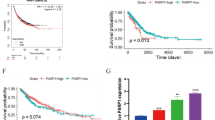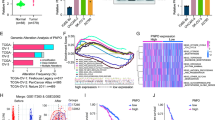Abstract
As previously reported, a novel gene P28GANK conferred a multidrug resistant phenotype in gastric cancer cells. The aim of this study was to explore the role of P28GANK in the development of multidrug resistance (MDR) in osteosarcoma cells. P28GANK gene was found to be overexpressed at the mRNA level and the protein level in a cisplatin induced MDR osteosarcoma cell line Saos-2/CDDP compared to its parent cell line Saos-2. Here, we transfected the osteosarcoma cell line Saos-2 with eukaryotic expression vector of P28GANK. In vitro drug sensitivity assay suggested that Saos-2-P28GANK cells conferred resistance to both P-glycoprotein (P-gp)-related and P-gp-nonrelated drugs. Blocking P28GANK expression in MDR osteosarcoma cells Saos-2/CDDP by P28GANK-specific small interfering RNA (siRNA) increased the cell sensitivity to various chemotherapeutic drugs. Flow cytometry examination suggested that P28GANK gene expression could suppress Adriamycin-induced apoptosis accompanied by decreased accumulation and increased release of Adriamycin. Semiquantitative RT-PCR, Western blot and Luciferase reporter assay suggested that P28GANK gene could significantly up-regulate the expression of MDR-1 and Bcl-2, transcription of the MDR-1 gene and down-regulate the expression of Bax. In addition, inhibition of P28GANK expression by RNA interference or P-gp inhibition could partially reverse P28GANK-mediated MDR. Taken together, our findings suggest that down-regulation of P28GANK gene expression could sensitize osteosarcoma cells to chemotherapeutic drugs by down-regulation of the MDR-1 and Bcl-2 and up-regulation of Bax gene expression, without altering the glutathione S-transferase activity, or intracellular glutathione content in osteosarcoma cells. Further study on biological function of P28GANK may be helpful for understanding MDR mechanism of osteosarcoma and developing a strategy for osteosarcoma treatment.
Similar content being viewed by others
Abbreviations
- ADR:
-
adriamycin
- CDDP:
-
cisplatin
- MDR:
-
multidrug resistance
- MTX:
-
methotrexate
- MTT:
-
3-(4,5-dimethylthiazol-2-yl)-2,5-diphenyltetrazolium bromide
- P-gp:
-
P-glycoprotein
- VCR:
-
vincristine
References
Davis A.M., Bell R.S., Goodwin P.J. 1994. Prognostic factor in osteosarcoma: A critical review. J. Clin. Oncol. 12, 423–431.
Link M.P., Goorin A.M., Horowitz M., Meyer W.H., Belasco J., Baker A., Ayala A., Shuster J., 1991. Adjuvant chemotherapy of high-grade osteosarcoma of the extremity: Updated results of the Multi-Institutional Osteosarcoma Study. Clin. Orthop. 270, 8–14.
Saeter G., Elomaa I., Wahlqvist Y., Alvegård T.A., Wiebe T., Monge O., Forrestier E., Solheim O.P. 1997. Prognostic factors in bone sarcomas. Acta Orthop. Scand Suppl. 273, 156–160.
Bacci G., Picci P., Ferrari S., Ruggieri P., Casadei R., Tienghi A., Brach del Prever A., Gherlinzoni F., Mercuri M., Monti C. 1993. Primary chemotherapy and delayed surgery for nonmetastatic osteosarcoma of the extremities. Cancer. 72, 3227–3238.
Bramwell V.H. 1997. The role of chemotherapy in the management of nonmetastatic operable extremity osteosarcoma. Semin. Oncol. 24, 561–571.
Bruland Ø.S., Pihl A. 1997. On the current management of osteosarcoma: A critical evaluation and a proposal for a modified treatment strategy. Eur. J. Cancer. 33, 1725–1731.
Litman T., Druley T.E., Stein W.D., Bates S.E. 2001. From MDR to MXR: New understanding of multidrug resistance systems, their properties and clinical significance. Cell. Mol. Life Sci. 58, 931–935.
Larsen A.K., Escargueil A.E., Skladanowski A. 2000. Resistance mechanisms associated with altered intracellular distribution of anticancer agents. Pharmacol. Ther. 85, 217–229.
Ross D.D. 2000. Novel mechanisms of drug resistance in gastric cancer. Gastric Cancer. 14, 467–473.
Fan D., Zhang X., Chen X. 2005, Bird’s-eye view on gastric cancer research of the past 25 years. J. Gastroenterol. Hepatol. 20(3), 360–365.
Narasaki F., Oka M., Nakano R., Ikeda K., Fukuda M., Nakamura T., Soda H., Nakagawa M., Kuwano M., Kohno S. 1997. Human canalicular multispecific organic anion transporter (cMOAT) is expressed in human lung, gastric, and colorectal cancer cells. Biochem. Biophys. Res. Commun. 240, 606–611.
Nakamura T., Oka M., Aizawa K., Soda H., Fukuda M., Terashi K., Ikeda K., Mizuta Y., Noguchi Y., Kimura Y., Tsuruo T., Kohno S. 1999. Direct interaction between a quinoline derivative, MS-209, and multidrug resistance protein (MRP) in human gastric cancer cells. Biochem. Biophys. Res. Commun. 255, 618–624.
Tomonaga M., Oka M., Narasaki F., Fukuda M., Nakano R., Takatani H., Ikeda K., Terashi K., Matsuo I., Soda H., Cowan K.H., Kohno S. 1996. The multidrug resistance-associated protein gene confers drug resistance in human gastric and colon cancers. Jpn. J. Cancer Res. 87, 1263–1270.
Johnstone R.W., Ruefli A.A., Lowe S.W. 2002. Apoptosis: A link between cancer genetics and chemotherapy. Cell. 108, 153–164.
Inoue S., Salah-Eldin A.E., Omoteyama K. 2001. Apoptosis and anticancer drug resistance. Hum. Cell. 14, 211–221.
Shibuya H., Kato Y., Saito M., Isobe T., Tsuboi R., Koga M., Toyota H., Mizuguchi J. 2003. Induction of apoptosis and/or necrosis following exposure to antitumour agents in a melanoma cell line, probably through modulation of Bcl-2 family proteins. Melanoma Res. 13, 457–464.
Grossman D., Altieri D.C. 2001. Drug resistance in melanoma: Mechanisms, apoptosis, and new potential therapeutic targets. Cancer Metastasis Rev. 20, 3–11.
Park T.J., Kim H.S., Byun K.H., Jang J.J., Lee Y.S., Lim I.K. 2001. Sequential changes in hepatocarcinogenesis induced by diethylnitrosamine plus thioacetamide in Fischer 344 rats: Induction of gankyrin expression in liver fibrosis, pRB degradation in cirrhosis, and methylation of p16(INK4A) exon 1 in hepatocellular carcinoma. Mol. Carcinogen. 30, 138–150.
Li J., Tsai M.D. 2002. Novel insights into the INK4-CDK4/6-Rb pathway: Counter action of gankyrin against INK4 proteins regulates the CDK4-mediated phosphorylation of Rb. Biochemistry. 41, 3977–3983.
Li X., Zhang Y., Xiong C., Jin H., Jing B., Zhang Y., Fan D. 2009. Overexpression of a new gene P28GANK confers multidrug resistance of gastric cancer cells. Cancer Invest. 27(2), 129–139.
Li H., Fu X., Chen Y., Hong Y., Tan Y., Cao H., Wu M., Wang H. 2005. Use of adenovirus-delivered siRNA to target oncoprotein p28GANK in hepatocellular carcinoma. Gastroenterology. 128, 2029–2041.
Lazarova D.L., Bordonaro M., Sartorelli A.C. 2001. Transcriptional regulation of the vitamin D3 receptor gene by ZEB. Cell Growth Differ. 12, 319–326.
Perkins C.L., Fang G., Kim C.N., Bhalla K. N. 2000. The role of Apaf-1, caspase-9, and bid proteins in etoposide- or paclitaxel-induced mitochondrial events during apoptosis. Cancer Res. 60, 1645–1653.
Bacci G., Ferrari S., Bertoni F., Ruggieri P., Picci P., Longhi A., Casadei R., Fabbri N., Forni C., Versari M., Campanacci M. 2000. Long-term outcome for patients with nonmetastatic osteosarcoma of the extremity treated at the Istituto Ortopedico Rizzoli according to the Istituto Ortopedico Rizzoli/Osteosarcoma-2 protocol: An updated report. J. Clin. Oncol. 18, 4016–4027.
Baldini N., Scotlandi K., Barbanti-Bròdano G., Manara M.C., Maurici D., Bacci G., Bertoni F., Picci P., Sottili S., Campanacci M., Massimo S. 1995. Expression of P-glycoprotein in high-grade osteosarcomas in relation to clinical outcome. N. Engl J. Med. 333, 1380–1385.
Bramwell V.H.C. 2000. Osteosarcomas and other cancers of bone. Curr. Opin. Oncol. 12, 330–336.
Serra M., Scotlandi K., Reverter-Branchat G., Ferrari S., Manara M.C., Benini S., Incaprera M., Bertoni F., Mercuri M., Briccoli A., Bacci G., Picci P. 2003. Value of P-glycoprotein and clinicopathologic factors as the basis for new treatment strategies in high-grade osteosarcoma of the extremities. J. Clin. Oncol. 21, 536–542.
Wandel C., Kim R.B., Kajiji S., Peter Guengerich F., Wilkinson G., Wood A. 1999. P-glycoprotein and cytochrome P-450 3A inhibition: Dissociation of inhibitory potencies. Cancer Res. 59, 3944–3948.
Agrawal M., Abraham J., Balis F.M., Edgerly M., Stein W.D., Bates S., Fojo T., Chen C.C. 2003. Increased 99mTc-sestamibi accumulation in normal liver and drug-resistant tumors after the administration of the glycoprotein inhibitor, XR9576. Clin. Cancer Res. 9, 650–656.
Naito M., Matsuba Y., Sato S., Hirata H., Tsuruo T. 2002. MS-209, a quinoline-type reversal agent, potentiates antitumor efficacy of docetaxel in multidrug-resistant solid tumor xenograft models. Clin. Cancer Res. 8, 582–588.
Sinicrope F.A., Dudeja P.K., Bissonnette B.M., Safa A.R., Brasitus T.A. 1992. Modulation of P-glycoprotein-mediated drug transport by alterations in lipid fluidity of rat liver canalicular membrane vesicles. J. Biol. Chem. 15, 24995–245002.
Gaitanos T.N., Buey R.M., Díaz J.F., Northcote P.T., Teesdale-Spittle P., Andreu J.M., Miller J.H. 2004. Peloruside A does not bind to the taxoid site on h-tubulin and retains its activity in multidrug-resistant cell lines. Cancer Res. 64, 5063–5067.
Cabot M.C., Giuliano A.E., Han T.Y., Liu Y.Y. 1999. SDZ PSC 833, the Cyclosporine A analogue and multidrug resistance modulator, activates ceramide synthesis and increases vinblastine sensitivity in drug-sensitive and drug-resistant cancer cells. Cancer Res. 59, 880–885.
Potocnik U., Glavac M.R., Golouh R., Glavac D. 2001. The role of P-glycoprotein (MDR1) polymorphisms and mutations in colorectal cancer. Pflugers Arch. 442, 182–183.
Igney F.H., Krammer P.H. 2002. Death and anti-death: Tumour resistance to apoptosis. Nature Rev. Cancer. 2, 277–288.
Oltvai Z.N., Milliman C.L., Korsmeyer S.J. 1993. Bcl-2 heterodimerizes in vivo with a conserved homolog, Bax, that accelerates programmed cell death. Cell. 74, 609–619.
Reed J.C. 1999. Dysregulation of apoptosis in cancer. J. Clin. Oncol. 17, 2941–2953.
Author information
Authors and Affiliations
Corresponding author
Additional information
The article is published in the original.
Rights and permissions
About this article
Cite this article
Wang, G., Rong, J., Zhou, Z. et al. A novel gene P28GANK confers multidrug resistance by modulating the expression of MDR-1, Bcl-2, and bax in osteosarcoma cells. Mol Biol 44, 898–906 (2010). https://doi.org/10.1134/S0026893310060063
Received:
Accepted:
Published:
Issue Date:
DOI: https://doi.org/10.1134/S0026893310060063




